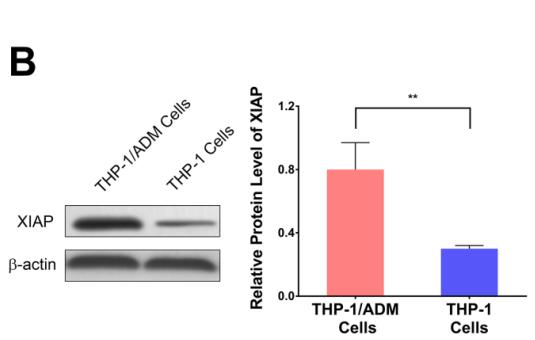产品描述
*The optimal dilutions should be determined by the end user.
*Tips:
WB: 适用于变性蛋白样本的免疫印迹检测. IHC: 适用于组织样本的石蜡(IHC-p)或冰冻(IHC-f)切片样本的免疫组化/荧光检测. IF/ICC: 适用于细胞样本的荧光检测. ELISA(peptide): 适用于抗原肽的ELISA检测.
引用格式: Affinity Biosciences Cat# AF6368, RRID:AB_2835212.
展开/折叠
AP 13; API3; Apoptosis Inhibitor 3; Baculoviral IAP repeat containing 4; Baculoviral IAP Repeat Containing Protein 4; Baculoviral IAP repeat-containing protein 4; BIRC 4; BIRC4; E3 ubiquitin-protein ligase XIAP; hIAP-3; hIAP3; HILP; IAP 3; IAP like protein; IAP-3; IAP-like protein; IAP3; ILP 1; ILP; ILP1; Inhibitor of apoptosis protein 3; Inhibitor of Apoptosis X Linked; Mammalian IAP Homologue A; MIHA; X linked IAP; X linked inhibitor of apoptosis; X linked inhibitor of apoptosis E3 ubiquitin protein ligase; X linked inhibitor of apoptosis protein; X-linked IAP; X-linked inhibitor of apoptosis protein; Xiap; XIAP_HUMAN; XLP2;
抗原和靶标
- P98170 XIAP_HUMAN:
- Protein BLAST With
- NCBI/
- ExPASy/
- Uniprot
MTFNSFEGSKTCVPADINKEEEFVEEFNRLKTFANFPSGSPVSASTLARAGFLYTGEGDTVRCFSCHAAVDRWQYGDSAVGRHRKVSPNCRFINGFYLENSATQSTNSGIQNGQYKVENYLGSRDHFALDRPSETHADYLLRTGQVVDISDTIYPRNPAMYSEEARLKSFQNWPDYAHLTPRELASAGLYYTGIGDQVQCFCCGGKLKNWEPCDRAWSEHRRHFPNCFFVLGRNLNIRSESDAVSSDRNFPNSTNLPRNPSMADYEARIFTFGTWIYSVNKEQLARAGFYALGEGDKVKCFHCGGGLTDWKPSEDPWEQHAKWYPGCKYLLEQKGQEYINNIHLTHSLEECLVRTTEKTPSLTRRIDDTIFQNPMVQEAIRMGFSFKDIKKIMEEKIQISGSNYKSLEVLVADLVNAQKDSMQDESSQTSLQKEISTEEQLRRLQEEKLCKICMDRNIAIVFVPCGHLVTCKQCAEAVDKCPMCYTVITFKQKIFMS
种属预测
score>80的预测可信度较高,可尝试用于WB检测。*预测模型主要基于免疫原序列比对,结果仅作参考,不作为质保凭据。
High(score>80) Medium(80>score>50) Low(score<50) No confidence
研究背景
Multi-functional protein which regulates not only caspases and apoptosis, but also modulates inflammatory signaling and immunity, copper homeostasis, mitogenic kinase signaling, cell proliferation, as well as cell invasion and metastasis. Acts as a direct caspase inhibitor. Directly bind to the active site pocket of CASP3 and CASP7 and obstructs substrate entry. Inactivates CASP9 by keeping it in a monomeric, inactive state. Acts as an E3 ubiquitin-protein ligase regulating NF-kappa-B signaling and the target proteins for its E3 ubiquitin-protein ligase activity include: RIPK1, CASP3, CASP7, CASP8, CASP9, MAP3K2/MEKK2, DIABLO/SMAC, AIFM1, CCS and BIRC5/survivin. Ubiquitinion of CCS leads to enhancement of its chaperone activity toward its physiologic target, SOD1, rather than proteasomal degradation. Ubiquitinion of MAP3K2/MEKK2 and AIFM1 does not lead to proteasomal degradation. Plays a role in copper homeostasis by ubiquitinationg COMMD1 and promoting its proteasomal degradation. Can also function as E3 ubiquitin-protein ligase of the NEDD8 conjugation pathway, targeting effector caspases for neddylation and inactivation. Regulates the BMP signaling pathway and the SMAD and MAP3K7/TAK1 dependent pathways leading to NF-kappa-B and JNK activation. Acts as an important regulator of innate immune signaling via regulation of Nodlike receptors (NLRs). Protects cells from spontaneous formation of the ripoptosome, a large multi-protein complex that has the capability to kill cancer cells in a caspase-dependent and caspase-independent manner. Suppresses ripoptosome formation by ubiquitinating RIPK1 and CASP8. Acts as a positive regulator of Wnt signaling and ubiquitinates TLE1, TLE2, TLE3, TLE4 and AES. Ubiquitination of TLE3 results in inhibition of its interaction with TCF7L2/TCF4 thereby allowing efficient recruitment and binding of the transcriptional coactivator beta-catenin to TCF7L2/TCF4 that is required to initiate a Wnt-specific transcriptional program.
S-Nitrosylation down-regulates its E3 ubiquitin-protein ligase activity.
Autoubiquitinated and degraded by the proteasome in apoptotic cells.
Phosphorylation by PKB/AKT protects XIAP against ubiquitination and protects the protein against proteasomal degradation.
Cytoplasm. Nucleus.
Note: TLE3 promotes its nuclear localization.
Ubiquitous, except peripheral blood leukocytes.
Monomer, and homodimer. Interacts with DIABLO/SMAC and with PRSS25; these interactions inhibit apoptotic suppressor activity. Interacts with TAB1/MAP3K7IP1 and AIFM1. Interaction with SMAC hinders binding of TAB1/MAP3K7IP1 and AIFM1. Interacts with TCF25 and COMMD1. Interacts with SEPTIN4 isoform 6, but not with other SEPTIN4 isoforms. Interacts with RIP1, RIP2, RIP3, RIP4, CCS and USP19. Interacts (via BIR 2 domain and BIR 3 domain) with HAX1 (via C-terminus) and this interaction blocks ubiquitination of XIAP/BIRC4. Interacts with the monomeric form of BIRC5/survivin. Interacts with TLE3 and TCF7L2/TCF4. Interacts (via BIR 3 and RING domains) with PDCL3.
The first BIR domain is involved in interaction with TAB1/MAP3K7IP1 and is important for dimerization. The second BIR domain is sufficient to inhibit CASP3 and CASP7, while the third BIR is involved in CASP9 inhibition. The interactions with DIABLO/SMAC and PRSS25 are mediated by the second and third BIR domains.
Belongs to the IAP family.
研究领域
· Cellular Processes > Cell growth and death > Apoptosis. (View pathway)
· Cellular Processes > Cell growth and death > Apoptosis - multiple species. (View pathway)
· Cellular Processes > Cell growth and death > Necroptosis. (View pathway)
· Cellular Processes > Cellular community - eukaryotes > Focal adhesion. (View pathway)
· Environmental Information Processing > Signal transduction > NF-kappa B signaling pathway. (View pathway)
· Genetic Information Processing > Folding, sorting and degradation > Ubiquitin mediated proteolysis. (View pathway)
· Human Diseases > Drug resistance: Antineoplastic > Platinum drug resistance.
· Human Diseases > Infectious diseases: Parasitic > Toxoplasmosis.
· Human Diseases > Infectious diseases: Viral > HTLV-I infection.
· Human Diseases > Cancers: Overview > Pathways in cancer. (View pathway)
· Human Diseases > Cancers: Specific types > Small cell lung cancer. (View pathway)
· Organismal Systems > Immune system > NOD-like receptor signaling pathway. (View pathway)
文献引用
Application: WB Species: Mouse Sample: Phodopus sungorus
Application: WB Species: human Sample: THP-1/ADM cells
限制条款
产品的规格、报价、验证数据请以官网为准,官网链接:www.affbiotech.com | www.affbiotech.cn(简体中文)| www.affbiotech.jp(日本語)产品的数据信息为Affinity所有,未经授权不得收集Affinity官网数据或资料用于商业用途,对抄袭产品数据的行为我们将保留诉诸法律的权利。
产品相关数据会因产品批次、产品检测情况随时调整,如您已订购该产品,请以订购时随货说明书为准,否则请以官网内容为准,官网内容有改动时恕不另行通知。
Affinity保证所销售产品均经过严格质量检测。如您购买的商品在规定时间内出现问题需要售后时,请您在Affinity官方渠道提交售后申请。产品仅供科学研究使用。不用于诊断和治疗。
产品未经授权不得转售。
Affinity Biosciences将不会对在使用我们的产品时可能发生的专利侵权或其他侵权行为负责。Affinity Biosciences, Affinity Biosciences标志和所有其他商标所有权归Affinity Biosciences LTD.


